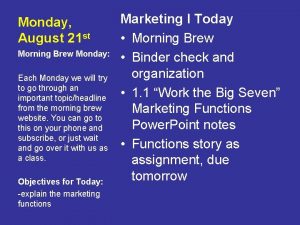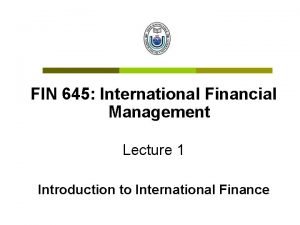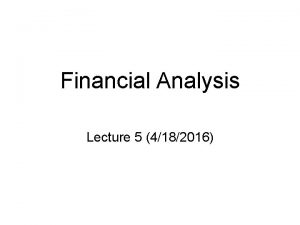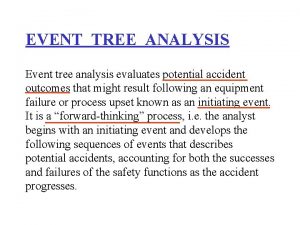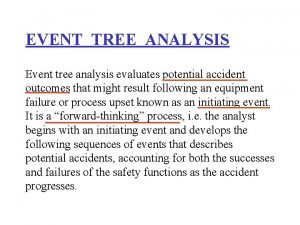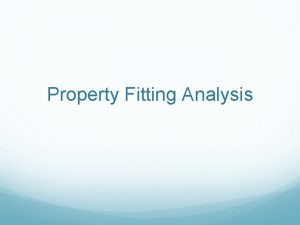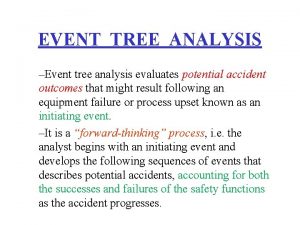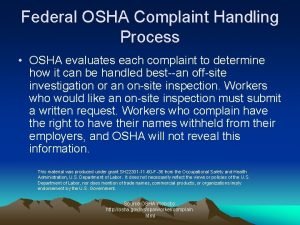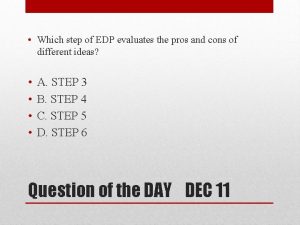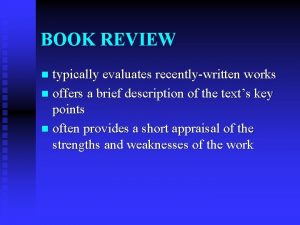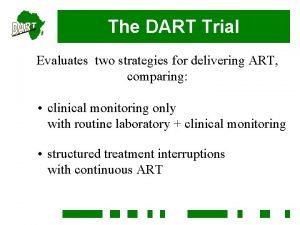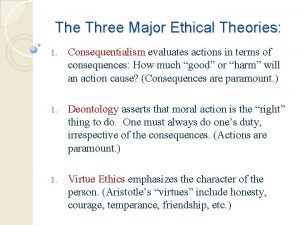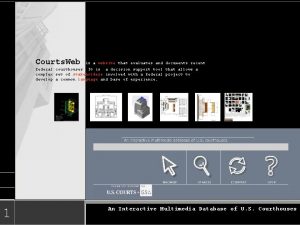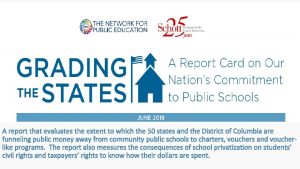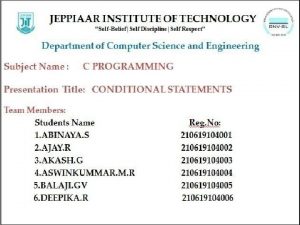Financial Analysis Lecture 4 4122017 Financial Analysis Evaluates










































- Slides: 42

Financial Analysis Lecture 4 (4/12/2017)

Financial Analysis Ø Evaluates management alternatives based on financial profitability; Ø Evaluates the opportunity costs of alternatives; Ø Cash flows of costs and revenues; Ø The timing of payments is important. Why?

What is discounting? A process that accounts for time preferences Ø Converts future values to present values Ø Compounding Present Value A value expressed in dollars received immediately Future Value Discounting A value expressed in dollars received at some future time

Definition of Discounting Ø The process of converting values expressed in dollars received at one point in time to an equivalent value expressed in dollars received at an earlier point in time Ø Compounding is the reverse process) FUTURE NOW

The interest rate Ø Time preference: = human nature + potential investments Ø Money can make money over time Ø Corollary: using money costs money Ø The interest rate determines the relationship between present and future values

Interest rate as a trade-off (the economy of Robinson Crusoe, Buongiorno & Gilles 2003) Amount next year (C 1) B C 1* T E 2 C 0* 0 E* I* A E 1 Present consumption (C 0) Source: Buongiorno and Gilles 2003, p. 374

The interest rate Ø Also: the interest rate is the percentage of the amount invested or borrowed that is paid in interest after one unit of time

Discounting Multiple Payments/Costs

The Net Present Value (NPV) Ø The NPV is the present value of revenues minus the present value of costs:

Cash flows Shearing, spraying, weeding, etc. Land, machinery, seedlings, planting, etc.

Derivation of the infinite annual series formula 2. Leave $100 in a bank account forever at an interest rate of 5%. How much can you withdraw each year? Answer: $100*0. 05=$5/yr 3. In other words: 1.

Infinite annual series Ø Present value: Ø The payment: Ø The interest: NOW R R R R

Infinite series of periodic payments Let’s use the infinite annual payment formula, but substitute the annual interest rate with a 40 year compound interest rate:

Infinite periodic series Ø Present value: Ø The payment: Ø The interest:

Infinite series of periodic payments (the aspen example) Ø So, how much is the present value of the revenues generated by the aspen stand at a 6% interest rate? Ø Solution:

Finite series of annual payments Ø Examples: l l l Calculating regular, annual payments on a loan for a fix period of time; Calculating annual rent/tax payments or management costs for a fix period of time; Or, calculating monthly payments. Ø Calculating monthly interest rates:

Finite series of annual payments Ø Derivation of the formula: R Year n

Finite series of annual payments

Example Ø You want to buy a house in Seattle for $500, 000. You have $100, 000 to put down, so you get a loan with a 5. 0% interest. How much would you have to pay each month to pay the loan off within 30 years?

Solution procedure cont. 1. Convert the annual interest rate of 5% to a monthly interest rate 2. Plug in the monthly interest rate in the finite annual payments formula:

Finite series of periodic payments There is a fixed amount (R) that you receive or pay every t years for n years (where n is an integer multiple of t); Ø Example: An intensively managed black locust stand (Robinia pseudoacacia) is coppiced three times at 20 -year intervals. After the third coppice (at age 60), the stand has to be replanted. At ages 20, 40 and 60 yrs the stand produces $1, 000 per acre. Using a 5% discount rate, what would the present value of these harvests be? Ø

Solution procedure What do we know? Ø 1. 2. 3. R 20=$1, 000 n=60 yrs, t=20 yrs i=5%=0. 05 What do we need to know? Ø l Present Value (V 0) What formula to use? Ø l Use the finite annual payment formula with a 20 -year compound interest rate.

Solution procedure cont. Ø First let’s calculate the 20 year compound interest rate: Ø Plug in the 20 -yr interest rate into the finite annual series formula:

Finite periodic payments formula Ø In general: Ø The payment to achieve a given present value:

Discounting with Inflation

Definition Ø Inflation: an increase in average price level, reducing the purchasing power of a unit currency (deflation is the reverse process) Ø Inflation rate: average annual rate of increase in the price of goods

Measuring Inflation Ø Consumer Price Index (CPI)*: measures the average increase in the cost of a standard collection of consumer goods (market basket) Ø Producer Price Index (PPI): measures the average increase in the cost of a standard collection of production inputs *CPI: the Consumer Price Index for All Urban Consumers (CPI-U) for the U. S. City Average for All Items, 1982 -84=100.

The Average Annual Inflation Rate Ø Example: Calculate the average annual inflation rate for the last 30 years (1985 -2015) Ø Solution: Use the website at http: //stats. bls. gov to get CPIs:

Components of the Interest Rate Ø The nominal rate: includes both the cost of capital and inflation; Ø The real rate: is the rate earned on an investment after accounting for inflation. This is the real return for investing one’s money. the nominal rate ≈ the inflation rate + the real rate i≈k+r

Combining Interest Rates Let i = the nominal rate; Ø r = the real rate; and Ø k = the inflation rate. Ø

Combining Interest Rates Ø Example: You bought a house in 1985 for $120, 000. In 2015 it was appraised at $450, 000. How much was your real rate of return on this house if the average annual inflation rate between 1985 and 2015 was 2. 285%?

Ø Solution: l Which formula to use? l How do we calculate i ? l Calculate r:

Deflating and Inflating Ø Deflating: The process of converting a value expressed in the currency of a given point in time into a value expressed in the currency of an earlier time with the same purchasing power ; Ø Inflating: is the reverse process. Note: Historical inflation rates are available to inflate past values to the present.

Compounding Present Value A value expressed in dollars received immediately Future Value Discounting Inflating A value expressed in dollars with the same purchasing power as dollars today Real Future Value Adjusts for time preference Nominal Future Value Deflating A value expressed in dollars received at some future time Adjusts for the change in purchasing power A value expressed in dollars that have the purchasing power of dollars in the year when the value occurs

Deflating and Inflating Note: Deflating/inflating is mathematically same as discounting/compounding but conceptually very different.

Example 1 Ø How much would a salary of $69, 000 in 2020 be worth in current (2014) dollars if the forecasted average annual inflation rate is 4%? Ø Solution:

Example 2 How much would a salary of $15, 000 in 1976 be worth in current dollars (2014)? Ø Solution: Ø

Example 2

Rules of discounting with inflation Ø Discount nominal future values with a nominal rate and discount real future values with a real rate; Ø When a present value is compounded by a real rate, then the result is a real future value; Ø When a present value is compounded by a nominal rate, then the result is a nominal future value.

Discounting with inflation Other terms: constant, relative or deflated $ Other terms: current, actual or inflated $ deflating k ng g ou nd in mp i un ti g in nd ou i=r+k+rk co mp co inflating g n nti ou c dis r Nominal Future Value (Vn*) dis co Real Future value (Vn) Present value (V 0) Note: It is often hard to tell if a future value is real or nominal

A hybrid poplar plantation Ø The plantation can be established for $600/ac on a land that can be rented for $100/ac/year. You expect the land rent to go up at about the same rate as the inflation rate (=4%/year). After 7 years, the plantation will produce 20 tons of chips per acre. The current price for chips is $100/ton and you expect this price to go up at the rate of the inflation. What is the present value of the poplar project at an 8% real interest rate?

Ø The cash flows Future Values Year k = 4% r = 8% Real Nominal (constantk (current values) i Present Values ($) 0 -700. 00 1 -100 -104. 00 -92. 59 2 -100 r -108. 16 -85. 63 3 -100 -112. 49 -79. 38 4 -100 -116. 99 -73. 50 5 -100 -121. 67 -68. 06 6 -100 -126. 53 -63. 02 7 2000 2631. 86 1, 166. 98 NPV N/A 4. 69
 Identifies, selects, monitors, and evaluates sales channels
Identifies, selects, monitors, and evaluates sales channels The aspire test evaluates students in subject areas
The aspire test evaluates students in subject areas Ecological risk assessment definition
Ecological risk assessment definition 01:640:244 lecture notes - lecture 15: plat, idah, farad
01:640:244 lecture notes - lecture 15: plat, idah, farad Money-time relationship and equivalence
Money-time relationship and equivalence Financial management lecture
Financial management lecture Financial markets and institutions - ppt
Financial markets and institutions - ppt Exploratory data analysis lecture notes
Exploratory data analysis lecture notes Sensitivity analysis lecture notes
Sensitivity analysis lecture notes Factor analysis lecture notes
Factor analysis lecture notes Analysis of algorithms lecture notes
Analysis of algorithms lecture notes Streak plate
Streak plate Power system analysis lecture notes
Power system analysis lecture notes Non financial motivators
Non financial motivators Project procurement management lecture notes
Project procurement management lecture notes Lecture about sport
Lecture about sport Lecture on healthy lifestyle
Lecture on healthy lifestyle Existential nihilism
Existential nihilism Life lecture meaning
Life lecture meaning Randy pausch the last lecture summary
Randy pausch the last lecture summary Tensorflow lecture
Tensorflow lecture Theology proper lecture notes
Theology proper lecture notes Strategic management lecture
Strategic management lecture Geology lecture series
Geology lecture series Social psychology lecture
Social psychology lecture In text citation for a lecture
In text citation for a lecture Public sector definition
Public sector definition 4 p's of management spectrum
4 p's of management spectrum Reinforcement lap lengths eurocodes
Reinforcement lap lengths eurocodes Magnetism
Magnetism Classical mechanics
Classical mechanics Physics 101 lecture notes pdf
Physics 101 lecture notes pdf Physical science lecture notes
Physical science lecture notes Power system dynamics and stability lecture notes
Power system dynamics and stability lecture notes Natural language processing nlp - theory lecture
Natural language processing nlp - theory lecture Microbial physiology notes
Microbial physiology notes Sensors and actuators lecture notes
Sensors and actuators lecture notes Ternology
Ternology Objectif de la lecture
Objectif de la lecture Instruction de lecture et d'écriture
Instruction de lecture et d'écriture Lecture carte aéronautique
Lecture carte aéronautique Lecture title
Lecture title Slidetodoc.com
Slidetodoc.com
